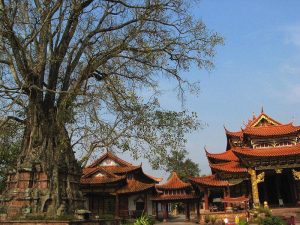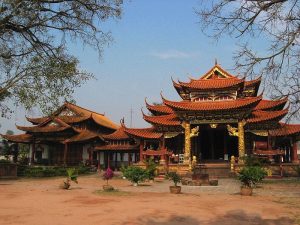Twins Pagodas of Mengwo Temple in Jinggu County, Puer

Chinese Name:景谷勐卧佛寺双塔
English Name: Twins Pagodas of Mengwo Temple in Jinggu County, Puer
Chinese Pinying: Jing Gu Meng Wo Fo Si Shuang Ta
Location: Jinggu County, Puer
Keywords: Tower, Ancient Temple
Admission Fee: Free
Opening hours: All day
Best Time To Visit: All year
Overview of the Twins Pagodas Buddhist Temple
The Twins Pagodas Buddhist Temple cover an area of more than 4,600 square meters. The buildings of the original Buddhist temple are divided into Sutra Mansion, Ordination Hall, Buddhist Palace, Buddhist temple, Monk Room, Temple Wall, Gate, Screen Wall and “eight” Wall, which are the most magnificent parts in this Buddhist temple in Jinggu county. The building consists of wooden structure and masonry structure, which is a public building from one to six stories.
Why is the Twins Pagodas Buddhist Temple so special

Mengwo Buddhist Temple is the highest class official Buddhist temple. The Buddhist temple is magnificent and majestic. It complements the spectacle of “Tower in Tree and Tree in Tower” and constitutes a more harmonious landscape. It has become an important venue for South Buddhism and a center for the spread of Buddhism culture. It enjoys a high Reputation in the country and even in Southeast Asia.
History of The Twins Pagodas Buddhist Temple
The two towers are on either side of the main hall, juxtaposed to the north and south. This temple was built in the late Ming and early Qing dynasties (1628~1661) by the Dai people, Dao Hancheng, a officer in weiyuan. This twin tower belongs to the Dai Buddhist temple of the South Buddhism. The tower was built with red sandstone, and the Ya-shaped raising lotus and multi-layered lotus on the sacred seat. The proverb is called “Mao Wu Wo Nan” (Lotus seat), square base, and each is 4 meters, the basal stone has a relief pattern, four corners with the “Ai Xiang Nong” (Hercules) stone carving for the tower column to support, and the tower body is a blue brick vertical chain cylinder. The Tower in Tree is 6 stories high, 10.74 meters high, and the Tree in Tower is 7.2 meters high, and the upper part is round. The tower has been replaced by a big tree. The two towers are 30 meters apart from each other and the tree height is about 2 times that of the tower.
What to see in the Twins Pagodas Buddhist Temple
The two towers have embossed Buddhist scriptures and folklore . Carved by Bian Ying (Sky God), Pa Zhao (Buddha), Hun He Wong Ga Tan Mu ( Monk Tang seng got to the India to get the scripture ), Man Mu Nuo Na ( Peacock Princess ), Zhao Shuzhen (Meng Ban Jia Prince), Jin Na Li, Jin Na La ( God Bird ), Wu Yi San Da La (Dan Bai Elephent), Zhu Za Ge A (Begger), Nan Jin (Crab Girl), Zhi Wei Leng ( Calling the moon ) and so on.
Animals and plant flowers are embossed: De En Bai Hou (Inverted Lion) , Re Long ( Flying Dragon ), Ma Mi ( Pegasus ), Nuo Yong ( Peacock ), Ge’an (Horse Deer), Ma Da Wan ( Sunflower ), South Wood Road ( Gourd ), Wu E Gui (Plantain Leaf), Mao Wu Wo (Lotus), Le Yuan (Sun), Yi An Hao (Teapot), etc., Which help the study of the Jinggu Yi people’s religion, culture, history, with historical and artistic value. The twin towers surrounded by green trees will allow visitors who come here to breathe the breath of history while feeling the scenery of nature.
How to Get to Twins Pagodas Buddhist Temple
1. By Air
The Jinggu General Airport Construction Project was officially launched on November 24, 2017. The project is the national A1 general airport construction project of the 13th Five-Year Plan of Yunnan Province, the “Wuwang” construction project of Yunnan Province. The airport is located in the west of Jinggu County, 7.5 kilometers away from the seat of Jinggu County.
2. By Train
Pu’er Railway Station is the middle station of the Yumo Railway under construction and an important station for the Laos section of the Trans-Asian Railway. It is expected to be put into use by 2020.
3. By Long-distance Bus
There is the Passenger Station in Jinggu County for people to get in.
4.Jinggu– The Twins Pagodas Buddhist Temple
Take the taxi or rent a car to go to the Twins Pagodas Buddhist Temple.
Where to Stay in Jinggu County
Jinggu County is a county under the jurisdiction of Pu’er City, Yunnan Province, China. There are many hotels around Jinggu County. Yunnan Exploration will provide the best hotels for you. The recommended hotels as follows:
1. Jinggu Weiyuanjiang International Hotel(景谷威远江国际大酒店)
Add: No.18 of Eastern Binghe Road, Jinggu County(景谷县滨河东路18号)
Tel: 0879-8886666
2. Haitian Hotel(海天酒店)
Add: No.23 of Wenming Road, Jinggu County(景谷县文明路23号)
Tel: 0879-5111666
3. Weijiangyuan Hotel(威江园酒店)
Add: No.88 of Mangxiang Avenue, Jinggu County(景谷县芒乡大道88号)
Tel: 0879-5111757
Best Time to Visit
It is suitable to visit Jinggu County all year round. Like many other cities in Yunnan, Jinggu is a place where the seasons are like spring. There is no cold, no heat, warm and humid, especially suitable for human habitation, so you can go to Jinggu at any time.
Recommended Tour
When you traveling Pu’er, Jinggu County is a good place to be put on your list. It can be joined in whatever your Pu’er tour or Yunnan Tour.
11 Days Yunnan Ancient Tea-Horse Road Tour with Puer and XishuangBanna Tea Culture Exploration
14 Days Southwest Yunnan Tea Culture Tour from Xishuangbanna to Puer and Lincang
Travel Tips

1.There are many ethnic minorities living here, such as Lahu, Hani, Wa and Yi. Varied customs make it a colorful city. Eating habits, ceremonies, costumes and folk legends can all be a strong attraction for people who are visiting. In addition, the city is the hometown of the well known Puer Tea, and the local people have diversified ways of handling tea, such as bamboo tube tea, cold tea dish, earth-pot tea and baked tea; all of which you should try.
2.Enjoying a plateau monsoon climate at low latitude, the region is affected by the Indian Ocean and the Bay of Bengal. Therefore, the main features of its weather are mildness and humidity without strong winds.
3.Special Local Products: Puer Tea, bamboo shoot, edible fungi, purple rice, mango.

 7 Days GolfingTour
7 Days GolfingTour
 8 Days Group Tour
8 Days Group Tour
 8 Days Yunnan Tour
8 Days Yunnan Tour
 7 Days Shangri La Hiking
7 Days Shangri La Hiking
 11 Days Yunnan Tour
11 Days Yunnan Tour
 6 Days Yuanyang Terraces
6 Days Yuanyang Terraces
 11 Days Yunnan Tour
11 Days Yunnan Tour
 8 Days South Yunnan
8 Days South Yunnan
 7 Days Tea Tour
7 Days Tea Tour
 8 Days Muslim Tour
8 Days Muslim Tour
 12 Days Self-Driving
12 Days Self-Driving
 4 Days Haba Climbing
4 Days Haba Climbing
 Tiger Leaping Gorge
Tiger Leaping Gorge
 Stone Forest
Stone Forest
 Yunnan-Tibet
Yunnan-Tibet
 Hani Rice Terraces
Hani Rice Terraces
 Kunming
Kunming
 Lijiang
Lijiang
 Shangri-la
Shangri-la
 Dali
Dali
 XishuangBanna
XishuangBanna
 Honghe
Honghe
 Kunming
Kunming
 Lijiang
Lijiang
 Shangri-la
Shangri-la
 Yuanyang Rice Terraces
Yuanyang Rice Terraces
 Nujiang
Nujiang
 XishuangBanna
XishuangBanna
 Spring City Golf
Spring City Golf
 Snow Mountain Golf
Snow Mountain Golf
 Stone Mountain Golf
Stone Mountain Golf


















